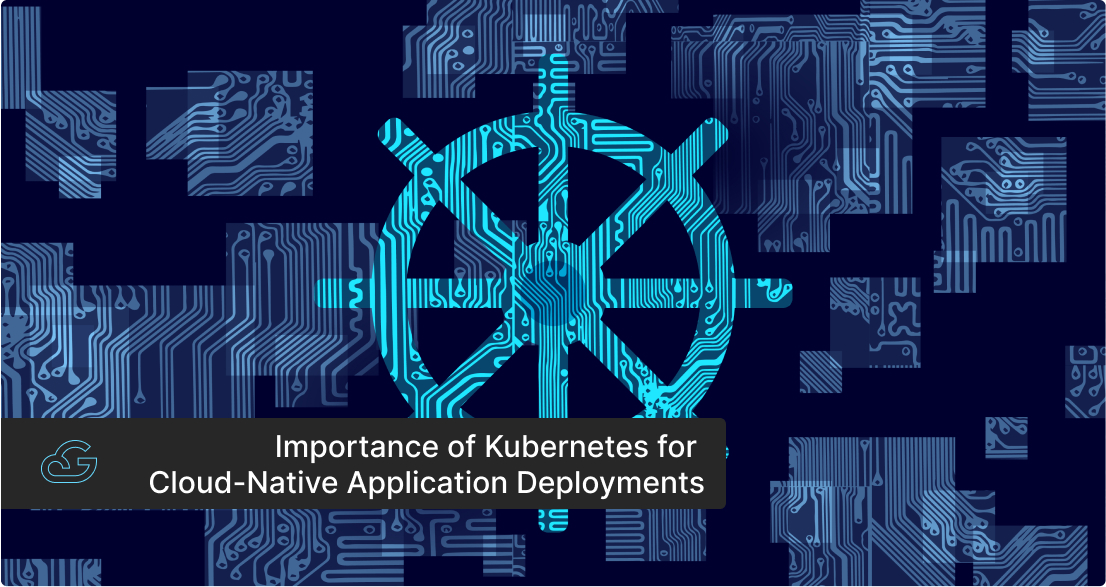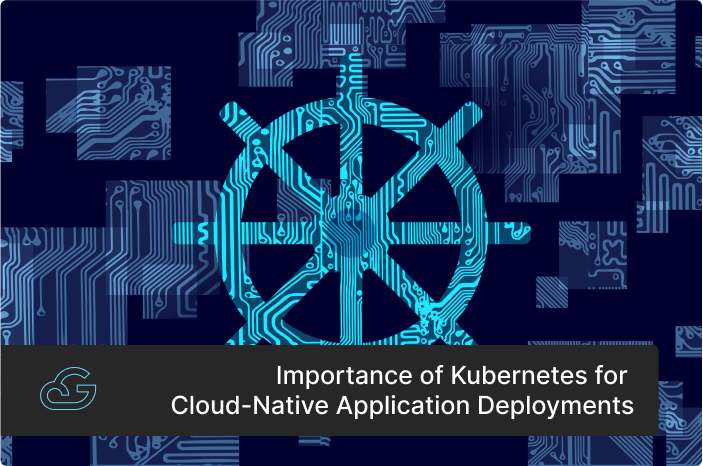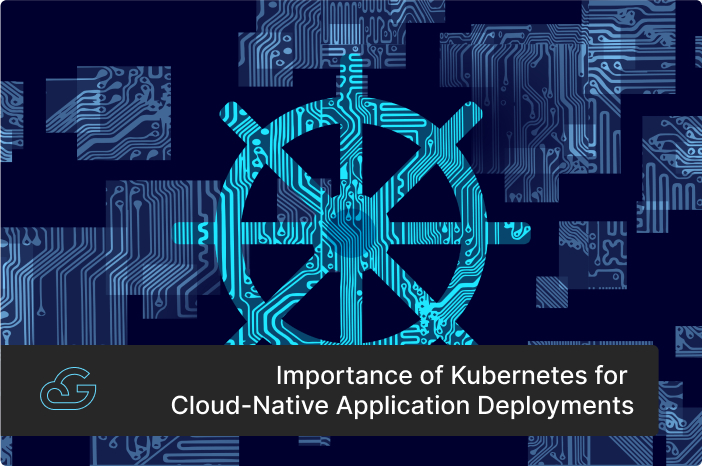Blogs / Kubernetes
Why is Kubernetes Essential for Cloud-Native Application Deployments?
By
Sherin Job Varghese
Posted: February 09, 2024
• 8 min 30 sec read
“Cloud-native” is a term that has gained significant traction during the last few years. It is the modern approach to building efficient software applications that can leverage the full potential of cloud technology. Unlike traditional applications, cloud-native applications have a microservices architecture. This means that instead of a rigid, monolithic structure, the application is broken down into smaller parts. Each of these parts, or microservices, is responsible for specific business functions.
Each microservice, along with its dependencies, is typically packaged in its own container. This containerization and microservices architecture deliver numerous benefits, like increased agility, flexibility, and much more. However, despite all its benefits, cloud-native development also comes with a host of challenges. Managing the complexities of deploying and orchestrating distributed applications across dynamic cloud environments can be daunting for developers,IT administrators, and other users involved in the cloud-native development process. And this is where Kubernetes emerges as a solution.
In this blog, we will explore the challenges associated with cloud-native application deployment while highlighting the role of Kubernetes in solving these challenges. Let’s start by taking a closer look at the concept of Kubernetes and its key functionalities.
Kubernetes: Empowering Cloud-Native Application Development
Kubernetes, also referred to as “K8s” or “Kube”, is an open-source container orchestration platform designed to address the challenges associated with deploying and managing cloud-native applications. It primarily creates an abstraction layer for resource management, providing a unified platform for orchestrating containerized workloads. And by automating tasks such as container scheduling, scaling, load balancing, etc., Kubernetes ensures optimal resource utilization and high availability.
Here are some of the key features of Kubernetes that make it a pivotal aspect of cloud-native application deployment.
-
Auto-Scaling:
-
Horizontal Pod Autoscaling (HPA): Involves adding or removing pod replicas based on workload demand.
-
Vertical Pod Autoscaling (VPA): Involves adjusting resource requirements (processing power, memory, etc.) for individual pods.
-
Cluster Autoscaling: Involves scaling the capacity of the total cluster.
-
Declarative Model:
-
Supports DevSecOps:
-
Role-Based Access Control (RBAC): RBAC involves giving granular permissions and access controls for users and service accounts within the cluster, making sure that only authorized entities have access to sensitive resources and operations.
-
Network Policies: Kubernetes focuses on securing network pipelines by defining network policies that control the flow of traffic to and from pods within the cluster.
-
Secrets Management: Kubernetes comes with a built-in mechanism known as “Kubernetes Secrets” for storing and managing sensitive information like passwords, API keys, and certificates.
-
Integration with Security Scanning Tools: It can also be easily integrated with various third-party security scanning tools and solutions, allowing organizations to perform vulnerability assessments, code analysis, etc.
-
Resilience & Self-Healing:
-
Automatic Container Restarts: By automatically detecting container failure and restarting it, Kubernetes ensures the application remains accessible and operational all the time.
-
Replacement of Unhealthy Nodes: Kubernetes automatically detects unhealthy nodes in a cluster and replaces them to maintain the system’s desired state.
-
Workload Redistribution: By dynamically redistributing the workload from unhealthy pods or nodes, Kubernetes prevents performance degradation.
-
Extensibility:
-
Open-Source Community:
-
Multi-Cloud Support:
One of the most important features of Kubernetes is the auto-scaling mechanism. With this capability, the platform can automatically adjust the number of pod replicas or resources allocated to pods based on fluctuating demand. This feature optimizes resource utilization and ensures consistent performance.
These are the three ways in which the auto-scaling mechanism of a Kubernetes platform functions.
Kubernetes platforms function on a declarative model. Unlike issuing imperative commands to make specific changes to the systems, users can declare their desired state using configuration files (typically in YAML or JSON format). These instructions can include the desired number of pod replicas, resource requirements, networking pipelines, and various other parameters.
The Kubernetes platform then factors in all these instructions to automatically reconcile the current state of the system with the desired state. This simplifies management and promotes consistency by allowing users to focus on what they want the system to look like rather than how to achieve that state through manual intervention.
DevSecOps is an evolved form of DevOps that focuses on combining security measures throughout the software development and deployment lifecycle. Kubernetes supports DevSecOps practices through various techniques that enable organizations to incorporate security into every stage of development and deployment.
Here are some of the common techniques that Kubernetes offers.
Kubernetes is engineered to be highly resilient and capable of self-healing. With these attributes, Kubernetes enhances the reliability and availability of applications deployed on it while minimizing downtime, improving fault tolerance, and enabling enterprises to deliver a consistent user experience even in the face of unforeseen failures or disruptions.
Here are some of the resilience and self-healing mechanisms embedded in a Kubernetes platform.
Kubernetes has an architectural flexibility that allows the user to extend its functionality and integrate it with third-party tools and services. With its extensive API and plugin system, users can customize Kubernetes as per their unique requirements and develop custom controllers, networking plugins, storage drivers, etc.
For instance, users can develop custom controllers that watch the state of Kubernetes resources via the API server and merge the actual state with the desired state. These controllers can automate tasks or workflows within Kubernetes clusters, like managing application lifecycle events, implementing custom scaling policies, etc.
Kubernetes benefits from a vibrant open-source community and a rich ecosystem of tools, libraries, and extensions. This includes cloud providers offering managed Kubernetes services, third-party tools for monitoring, logging, and continuous integration/continuous deployment (CI/CD), and Helm charts that help with deploying popular applications.
This community-driven approach fuels innovation, collaboration, and the exchange of best practices among users and various contributors. The open-source community also ensures that the Kubernetes platform remains up-to-date with the current technological advancements and best practices in the cloud computing space.
With Kubernetes, users can deploy and orchestrate containerized applications across various cloud providers—AWS, Azure, GCP, etc. This cloud-agnostic characteristic allows organizations to prevent vendor lock-in while leveraging all the features and services offered by different cloud environments.
By abstracting away the underlying infrastructure differences, Kubernetes provides a consistent and unified management experience across cloud environments, thereby optimizing resource utilization and mitigating risks associated with reliance on a single cloud provider.
These features help provide a solid understanding of the Kubernetes platform and the vital role it plays in cloud-native application development. But it is essential to note that these are just some of the most important features that we have mentioned here. As the technology landscape continues to advance, Kubernetes will undoubtedly introduce new features and enhancements, ensuring its ongoing relevance and adaptability.
Now, let’s shift our focus to the common challenges associated with cloud-native application deployment and how a Kubernetes platform can solve them.
Addressing Cloud-Native Deployment Challenges with Kubernetes
By adopting a cloud-native methodology, companies are revolutionizing how they approach software development. They are able to reduce their time to market and deploy software applications that are agile, resilient, and flexible. But, the same factors that make it unique can pose some significant challenges for organizations.
Navigating through these complexities necessitates a reliable solution capable of effectively managing cloud-native application deployments. And this is where Kubernetes comes into play, offering robust orchestration capabilities to streamline the process.
Let’s get into the details of how Kubernetes helps users mitigate the challenges of cloud-native deployments.
-
Container Orchestration:
-
Networking:
-
Monitoring & Visibility:
-
CI/CD Integration:
-
Security & Vendor Lock-In:
Managing containers across clusters of nodes and different cloud environments can be complicated. It involves various tasks such as scheduling, scaling, and resource allocation, all of which require meticulous coordination. Kubernetes streamlines these operations through automation, empowering developers to concentrate on application development and deployment, freeing them from infrastructure management concerns.
It automates container scheduling, adjusts the number of containers based on workload demands, and optimizes resource allocation across the cluster. This high level of automation simplifies container orchestration, enabling smoother workflows and enhanced efficiency.
Due to the highly distributed nature of the microservices architecture, networking in cloud-native environments poses significant challenges. It is extremely difficult to establish secure communication, facilitate service discovery, and manage network policies effectively, all of which are crucial for the deployment and operation of cloud-native applications. Kubernetes can help users bypass these challenges with its in-built networking capabilities, service discovery, load balancing, etc.
These capabilities play a vital role in facilitating effective communication between microservices within a cluster. Kubernetes enables this by abstracting away the complexities around individual pod IP addresses, which allows microservices to communicate with each other using a consistent DNS name. It also makes sure that the incoming traffic is distributed evenly across multiple instances of a service, enhancing reliability and scalability.
Monitoring and troubleshooting cloud-native applications is incredibly challenging due to their inherently distributed nature. Unlike traditional applications, users need to capture and analyze metrics, logs, and traces across various microservices and containers. This comprehensive monitoring approach is vital to maintaining optimal performance, identifying bottlenecks, and ensuring the reliability of cloud-native applications.
Kubernetes comes with built-in capabilities for monitoring cloud-native components and provisions for the integration of third-party tools like Prometheus and Grafana for more advanced data and insights. With these tools, users can effectively monitor the health and performance of clusters and applications while proactively identifying issues, troubleshooting problems, and ultimately ensuring the reliability and scalability of cloud-native deployments.
Continuous Integration and Continuous Deployment (CI/CD) are crucial in developing and deploying cloud-native applications. The CI/CD approach ensures rapid and reliable delivery of updates and features. However, implementing CI/CD pipelines in cloud-native environments is not straightforward and comes with several challenges that include managing complex build processes, coordinating deployments across different environments, and maintaining consistency in testing and deployment workflows.
Kubernetes helps users overcome these challenges by integrating with CI/CD pipelines through third-party tools such as Jenkins, GitLab CI, or Argo CD. Using APIs and integration points, these tools can be easily integrated into the Kubernetes platform and can automate various aspects of the deployment process while streamlining development workflows and enhancing collaboration.
Cloud-native environments often feature numerous interconnected components, which increases the attack surface and complexity of securing the infrastructure. Additionally, organizations may face the risk of vendor lock-ins when they become heavily dependent on a specific cloud provider’s service, making it challenging to migrate to alternative platforms or a multi-cloud environment.
Kubernetes can help address both of these challenges. As mentioned in the features section of this blog post, Kubernetes comes with security features such as Role-Based Access Control (RBAC), network policies, etc., which enforce effective protection against cyber threats. Kubernetes can also be integrated with third-party security tools and services for an advanced layer of protection. Furthermore, Kubernetes serves as a common abstraction layer that enables portability and interoperability across different cloud environments, helping users overcome the problem of vendor lock-in.
How Can Gsoft Cloud Help?
Integrating a Kubernetes platform into workflows demands proper planning and a deep understanding of cloud computing and associated technologies. To streamline this process and ensure seamless deployment and management of cloud-native applications, leverage Gsoft Cloud’s Managed Kubernetes Service.
Our service offers expert support, simplified deployment processes, and robust infrastructure, enabling organizations to harness the full potential of Kubernetes without the complexities of self-management.
By partnering with Gsoft Cloud, you can experience:
-
Rapid development and deployment cycles.
-
Improved developer productivity.
-
Efficient container orchestration.
-
Enhanced application scalability and availability.
-
Hassle-free cloud migration.
Summary:
Kubernetes has become an essential piece of the modern IT toolkit. With digital transformation in full swing and agility becoming a top priority among enterprises, its prevalence will keep growing in the technology landscape. While it offers countless advantages, organizations must be careful while integrating it into their workflows. Without good technical prowess and knowledge about cloud computing, it might result in operational overheads and unforeseen complexities.
Are you looking to incorporate Kubernetes into your workflows? Reach out to us at www.gsoftcomm.net.


Get Know More About Our Services and Products
Reach to us if you have any queries on any of our products or Services.











